 |
 |
|
 |
 |
PP SLR: Early history: 1948-1954:
Some pioneers. The first 7: Rectaflex, Gamma Duflex, Zeiss Ikon Contax S, Alpa Prisma Reflex, Exakta Varex, VEB Praktica, Zenit. (Duflex: No penta prism, Alpa: 45 degree viewer, not fully eye level.)
Some pioneers. The first 7: Rectaflex, Gamma Duflex, Zeiss Ikon Contax S, Alpa Prisma Reflex, Exakta Varex, VEB Praktica, Zenit. (Duflex: No penta prism, Alpa: 45 degree viewer, not fully eye level.)
Worlds first Penta Prism SLR:
I have worked hard to find the facts about which of these two was the worlds first PP SLR, the Rectaflex to the left, or the Contax S to the right.
In the beginning of my search I listened to what "everybody" said. Because "everybody", including Wikipedia and Camerapedia and so and so, have been stating that Contax S was first, just ahead of Rectaflex. Then I started to dig deeper, and I found another answer.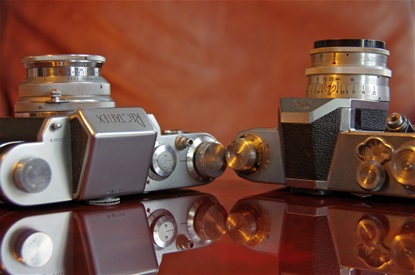
I have worked hard to find the facts about which of these two was the worlds first PP SLR, the Rectaflex to the left, or the Contax S to the right.
In the beginning of my search I listened to what "everybody" said. Because "everybody", including Wikipedia and Camerapedia and so and so, have been stating that Contax S was first, just ahead of Rectaflex. Then I started to dig deeper, and I found another answer.
When digging deeper into Italian sources, and holding it against the many German ones, especially the Dresden historians, I am reaching a conclusion:
The constructors of Contax of Dresden, Germany, had been working on the idea of a penta prism slr camera since late 30s. In Italy, Telemaco Corsi started working on his project in 1946, showing a prototype in '47, and his final prototype at the Milano Fiera in April/May of 1948. The Contax S was first shown at a fair in Sweden late summer of 1948. The Rectaflex started production during fall of '48 and had started selling and exporting their first cameras by October. Contax S was finally and officially presented at Leipzig Spring Fair in 1949, and it was series produced from September and for sale towards the end of the same year. (It is with great pleasure, however, I find that major Wikipedia articles on the subject as from 2017 have accepted the Rectaflex as worlds number one.)
So, what is so often repeated simply is not true. A timeline is following:
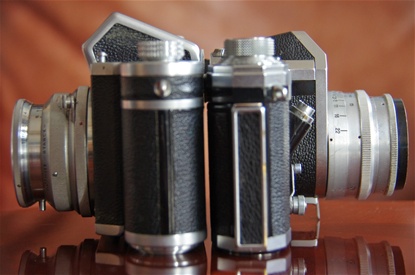
Timeline Rectaflex vs. Contax S:
1936-38: Contax: PP SLR project called Syntax starts in Dresden,Germany.
1939-1945: World War II. Dresden heavily bombed, prototypes/drawings destroyed
1946/May: Rectaflex: Telemaco Corsi starts PP SLR project in Rome, Italy.
1946: Contax: New group settled to restart the PP SLR project.
1947/June:Rectaflex: 1.mod 947 partly functioning shown at Milano Fiera.
1948/April:Rectaflex: 2. mod Standard 947, fully functioning, shown at Milano Fiera.
1948/June:Rectaflex: starts production of 3. model preseries Standard 947.
1948/August 25th: Contax S:1. prototype (A) shown at St.Eriks Fair in Stockholm.
1948/September:Rectaflex starts series production of Standard A 1000 series
1948/October: Rectaflex starts sales and export to USA and France.
1948/Late:Rectaflex: 1. series partly withheld/withdrawn due to problems with long sh. times.
1949/March:Contax: Contax S prototype B/preseries shown at Leipzig Fair.
1949/April: Rectaflex launching series Standard B 2000 at Fiera Milano, production started.
1949/September: Rectaflex starts production of series Standard B 3000
1949/September: Contax S: starts preproduction, followed by series production.
1949/December: Contax S: stops production due to problems
1950/March: Contax S restarts production
Worlds first series produced 135 film penta prism slr camera: Rectaflex of Italy. Read more about Rectaflex under Lost Brands: Rectaflex! A very old Rectaflex being presented!!
The wonderful Rectaflex of Italy. The company was never strong and after some 10 000 produced units they ended in 1958, after having been reorganized into a Lichtenstein/Vaduz company since 1955. Differing from the Contax, all Rectaflexes had a Trigger Related Mirror! The first variants is sometimes called 1000, from the shutter speed, as opposed to the later ones called 1300. Within the 1000 series, there were several production series, from A.1000, B.2000, B.3000, B.4000, Junior, B.5000, B.16000 and 20000B.
Size: 154x92x48 mm. Weight: 693 g.
Sn. oldest: 2173. One of the very oldest from the 2000 series, as Marco Antonetto claims the lowest sn.number to be found is 2233!
More about this under Lost Brands: Rectaflex.
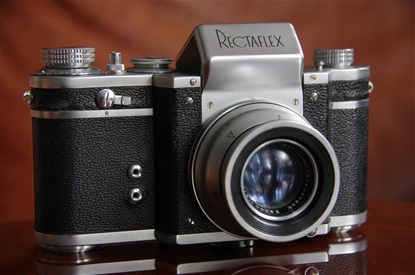
The wonderful Rectaflex of Italy. The company was never strong and after some 10 000 produced units they ended in 1958, after having been reorganized into a Lichtenstein/Vaduz company since 1955. Differing from the Contax, all Rectaflexes had a Trigger Related Mirror! The first variants is sometimes called 1000, from the shutter speed, as opposed to the later ones called 1300. Within the 1000 series, there were several production series, from A.1000, B.2000, B.3000, B.4000, Junior, B.5000, B.16000 and 20000B.
Size: 154x92x48 mm. Weight: 693 g.
Sn. oldest: 2173. One of the very oldest from the 2000 series, as Marco Antonetto claims the lowest sn.number to be found is 2233!
More about this under Lost Brands: Rectaflex.
One of the more common lenses on the Rectaflexes: Scneider-Kreuznach Xenon 50/2. Sn. 2145881.
One of the more common lenses on the Rectaflexes: Scneider-Kreuznach Xenon 50/2. Sn. 2145881.
Winder knob to the right, shutter release on the top plate, then timer wheel. Rewinder to the left, behind lens release knob. Sn. also on prism house. No ASA/DIN setting here. After all, you don't need it if there is no internal light metering system. Small handheld meters were quite usual at the time. Or you just read the light by experience and corrected for different ASA. This was the time before the producers tried to move brain from man to camera. 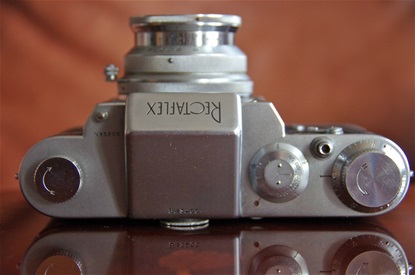
Winder knob to the right, shutter release on the top plate, then timer wheel. Rewinder to the left, behind lens release knob. Sn. also on prism house. No ASA/DIN setting here. After all, you don't need it if there is no internal light metering system. Small handheld meters were quite usual at the time. Or you just read the light by experience and corrected for different ASA. This was the time before the producers tried to move brain from man to camera.
Details: serial number. I have been wondering about this serial number. There is no mentioning anywhere of any Serial number between sn. 4450, the last known of the 4000 series, and the series starting with sn.16 001! So why this 13 255? I read the answer in Marco Antonettos book: Rectaflex - the Magic Reflex: Some cameras exported to the US, mainly between sn. 3 200 and 3 400, were given a higher sn. by just adding a 1 before the actual number! So, this camera is from the early B 3 000 series! And yes, it has the logo of the US distributor inside.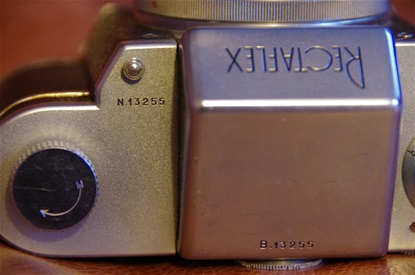
Details: serial number. I have been wondering about this serial number. There is no mentioning anywhere of any Serial number between sn. 4450, the last known of the 4000 series, and the series starting with sn.16 001! So why this 13 255? I read the answer in Marco Antonettos book: Rectaflex - the Magic Reflex: Some cameras exported to the US, mainly between sn. 3 200 and 3 400, were given a higher sn. by just adding a 1 before the actual number! So, this camera is from the early B 3 000 series! And yes, it has the logo of the US distributor inside.
Details: winder, shutter release button and shutter time dial.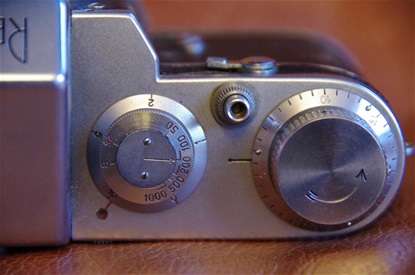
Details: winder, shutter release button and shutter time dial.
1949: East Germany: Zeiss Ikon Contax S:
Worlds second eye level pentaprism single lens reflex camera for 135 film: East German Zeiss Contax S (Spiegel). My sample is a type C (internal category, not engraved) from 1950 (first with self timer). In production from 1949/50 till 1952 in a quantity of 26 000. It was followed by official mod. D till '56. Then followed by model E and F in various editions till 1962. Total number of Contax/Pentacon: 187 000.
Size: 147x84x53. Weight: 550 g.
Sn: 10684. (First announced sn. as 44626, before learning about the double numbering on Contaxes. The real camera house sn. is inside the camera and shows a much lower number, 10 684. The number on the lower back of the outside of the camera is referring to another Contax numbering system.)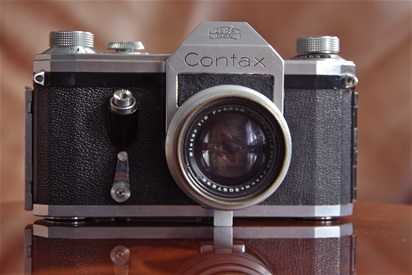
Worlds second eye level pentaprism single lens reflex camera for 135 film: East German Zeiss Contax S (Spiegel). My sample is a type C (internal category, not engraved) from 1950 (first with self timer). In production from 1949/50 till 1952 in a quantity of 26 000. It was followed by official mod. D till '56. Then followed by model E and F in various editions till 1962. Total number of Contax/Pentacon: 187 000.
Size: 147x84x53. Weight: 550 g.
Sn: 10684. (First announced sn. as 44626, before learning about the double numbering on Contaxes. The real camera house sn. is inside the camera and shows a much lower number, 10 684. The number on the lower back of the outside of the camera is referring to another Contax numbering system.)
Carl Zeiss Jena Biotar 58/2. Sn. 3057296.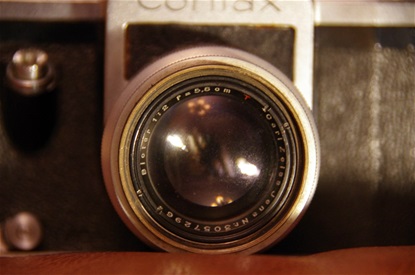
Carl Zeiss Jena Biotar 58/2. Sn. 3057296.
A very clean layout: Winder knob to the right side of the camera, timer dial with a glass covered display, knob rewinder on the left. Shutter release in 45 degrees on the front. 
A very clean layout: Winder knob to the right side of the camera, timer dial with a glass covered display, knob rewinder on the left. Shutter release in 45 degrees on the front.
Details from shutter time dial. Beautiful!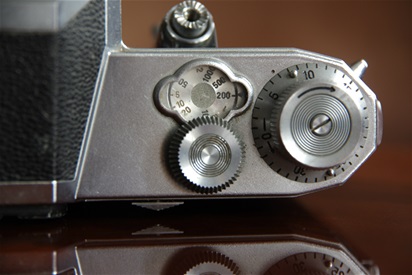
Details from shutter time dial. Beautiful!
1949: Switzerland: Alpa Prisma Reflex:
Alpa Prisma Reflex is by some counted as the third pentaprism eye level SLR to be launched. It was in 1949, and it was market ready before the Contax S! (Read more in the chapter called The Origin.) But was it an eye level pentaprism? Tecnically it was a penta prism construction. The noticable difference from the rest was the angle of the finder: it was bent 45 degrees upward, and thereby not what we would call a true eye-level PP SLR, as on had to look down into it.
The Alpa has a TRM (Trigger Related Mirror.) Size: 145x88x41(55) mm. Weight: 535 g.
Sn. 22477.
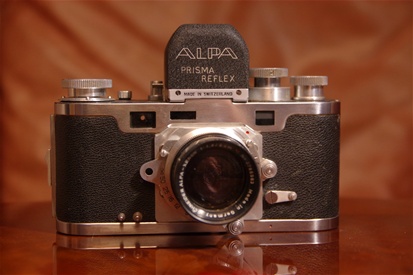
Alpa Prisma Reflex is by some counted as the third pentaprism eye level SLR to be launched. It was in 1949, and it was market ready before the Contax S! (Read more in the chapter called The Origin.) But was it an eye level pentaprism? Tecnically it was a penta prism construction. The noticable difference from the rest was the angle of the finder: it was bent 45 degrees upward, and thereby not what we would call a true eye-level PP SLR, as on had to look down into it.
The Alpa has a TRM (Trigger Related Mirror.) Size: 145x88x41(55) mm. Weight: 535 g.
Sn. 22477.
To the right: a big wheel for winding. The shutter release button is close to the prism house. Rewinder to the left of the shutter time knob. Finder tilted 45 degrees upward. 
To the right: a big wheel for winding. The shutter release button is close to the prism house. Rewinder to the left of the shutter time knob. Finder tilted 45 degrees upward.
1950: East Germany: Ihagee Exakta Varex:
Ihagee Exakta made the worlds first (or second) one eyed SLR in 1935/36: Kine Exakta. In '50 they presented their first PP SLR, the Varex, after having started production as early as February, thus being worlds third PP SLR brand. (Ruling out Alpa as it was not a true Eye- Level Penta Prism construction.) It was the worlds first SLR with interchangeable finder. Waist level finder was still the most common at the time, so most Varex were delivered as that. Pictured is my Varex from 1950.
Size: 151x95x49 mm. Weight: 675 g.
S/n 679389.
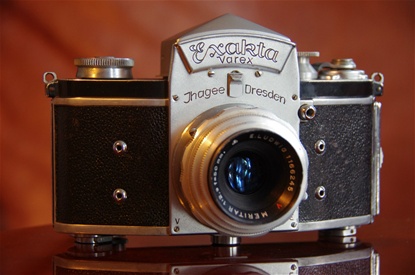
Ihagee Exakta made the worlds first (or second) one eyed SLR in 1935/36: Kine Exakta. In '50 they presented their first PP SLR, the Varex, after having started production as early as February, thus being worlds third PP SLR brand. (Ruling out Alpa as it was not a true Eye- Level Penta Prism construction.) It was the worlds first SLR with interchangeable finder. Waist level finder was still the most common at the time, so most Varex were delivered as that. Pictured is my Varex from 1950.
Size: 151x95x49 mm. Weight: 675 g.
S/n 679389.
Lens here is E. Ludwig Meritar 50/2,9. Rare. Sn. 1166245.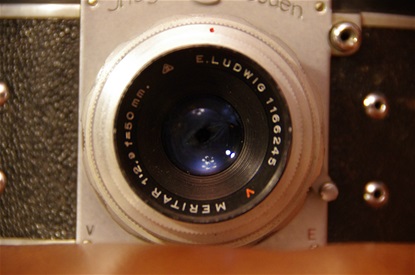
Lens here is E. Ludwig Meritar 50/2,9. Rare. Sn. 1166245.
Exakta tradition was to build camera houses where the front wall, rather than being parallell to the rear wall, was shaping a shallow V towards the lens. ASA/DIN setting to the right of the camera, shutter speeds to the left. Note that Exakta had a winder arm, not a knob or a wheel, as was usual, but placed to the left.
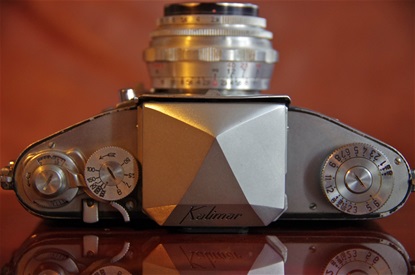
Exakta tradition was to build camera houses where the front wall, rather than being parallell to the rear wall, was shaping a shallow V towards the lens. ASA/DIN setting to the right of the camera, shutter speeds to the left. Note that Exakta had a winder arm, not a knob or a wheel, as was usual, but placed to the left.
1950-8: East Germany: KW Praktica:
The original from late 1950 is almost impossible to get, so I am showing a Praktica FX, from 1954. The body is identical to the first from 1950, it even has the same F and X contacts, as well as the selftimer. Only the letters FX can tell us that this one was produced later. The vast majority of the first Prakticas were fixed waist level SLRs - interchangeable PP SLRs were called Service Versions, and were made in very small numbers from the first one in 1950. The production of this PP FX rose to only 300, while the number of waist level FX'es was some 67 000! Read more about Praktica under http://www.pentax-slr.com/108413506
To the smallest detail, this is how the first Service version of the Praktica PP SLR looked. From this angle, the Tessar lens hides the FX letters. Interchangeable penta prism finder, self timer and FX contacts were some of its features in 1950, as it was on this model produced in 1954. Size: 152x110x50mm. Weight: 676 g.
Sn.: 137436.
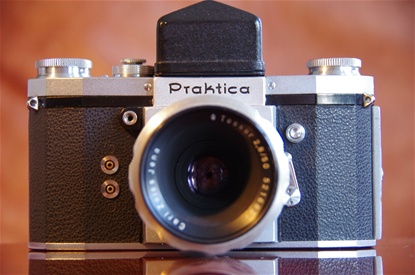
To the smallest detail, this is how the first Service version of the Praktica PP SLR looked. From this angle, the Tessar lens hides the FX letters. Interchangeable penta prism finder, self timer and FX contacts were some of its features in 1950, as it was on this model produced in 1954. Size: 152x110x50mm. Weight: 676 g.
Sn.: 137436.
Exactly as on the first edition from 1950, this house has a winder to the right with the shutter release on top. Shutter speed dial close to the prism, and rewinder knob to the left. 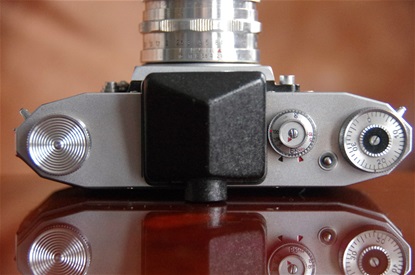
Exactly as on the first edition from 1950, this house has a winder to the right with the shutter release on top. Shutter speed dial close to the prism, and rewinder knob to the left.
1952: Soviet Union: KMZ Zenit 1:
Zenits (here written in cyrilic) first PP SLR came in 1952. Zenit was never a leader by technology, but they delivered very solid cameras that sold in high numbers. A beautiful camera that works well. Size: 134x91x50mm. Weight: 528 g. Sn. 5420961. 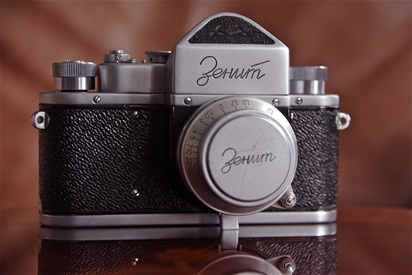
Zenits (here written in cyrilic) first PP SLR came in 1952. Zenit was never a leader by technology, but they delivered very solid cameras that sold in high numbers. A beautiful camera that works well. Size: 134x91x50mm. Weight: 528 g. Sn. 5420961.
Industar 50/3,5, a very compact lens.
Sn. 5416330.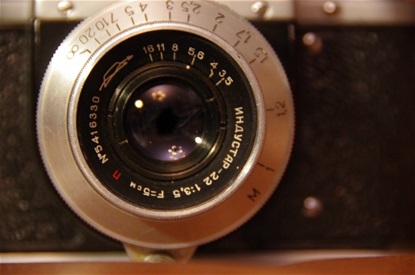
Industar 50/3,5, a very compact lens.
Sn. 5416330.
Older cameras sometimes had a top deck, as on most range finder cameras. Winder and counter to the right, rewinder to the left and shutter release button plus shutter speed on upper deck. A very neat camera, and the brightest viewer you can think of! 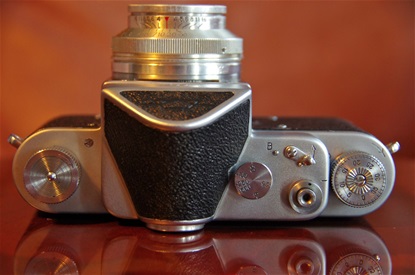
Older cameras sometimes had a top deck, as on most range finder cameras. Winder and counter to the right, rewinder to the left and shutter release button plus shutter speed on upper deck. A very neat camera, and the brightest viewer you can think of!
Detail from top deck Zenit 1.
Detail from top deck Zenit 1.
1953: West Germany: Zeiss Ikon Contaflex:
Zeiss Ikon Conteflex was the first PP SLR from West-Germany and the first with Leaf Shutter, a shutter build into the lens. The camera came in many versions in the years to come. Here is one from the first edition.
Size: 127x90x51mm. Weight: 684 g.
Sn. N 38855.
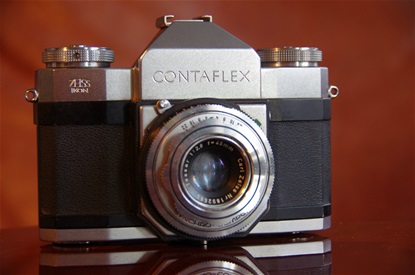
Zeiss Ikon Conteflex was the first PP SLR from West-Germany and the first with Leaf Shutter, a shutter build into the lens. The camera came in many versions in the years to come. Here is one from the first edition.
Size: 127x90x51mm. Weight: 684 g.
Sn. N 38855.
Carl Zeiss Tessar Synchro-Compur 45/2.8. Sn. 1692569. 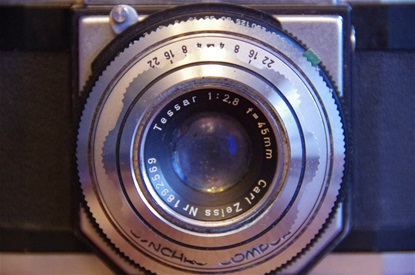
Carl Zeiss Tessar Synchro-Compur 45/2.8. Sn. 1692569.
Simple layout: Winder with counter and shutter release button to the right. Rewind knob with DIN scale to the left. Aperture, shutter speed and focus ring on the lens. Flashshoe on prism house.
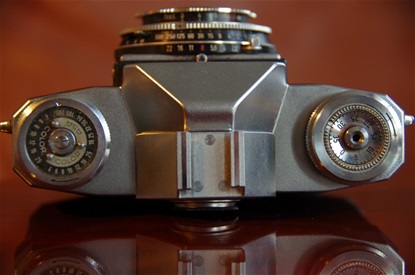
Simple layout: Winder with counter and shutter release button to the right. Rewind knob with DIN scale to the left. Aperture, shutter speed and focus ring on the lens. Flashshoe on prism house.
1953: East Germany: Praktina FX
Praktina FX from 1953 was the worlds first system camera, a title often given to Nikon F that came 6 years later. Interchangable finder for PP or waist level and motor possibility were some features. The extra finder beside the prism made it possible to follow the subject even if the main finder was black, as there was no Instant Returning Mirror. Many years should pass before any German camera, east or west, should build in an IRM.
Size: 147x95x57 mm. Weight: 665 g.
Serial number: 25543.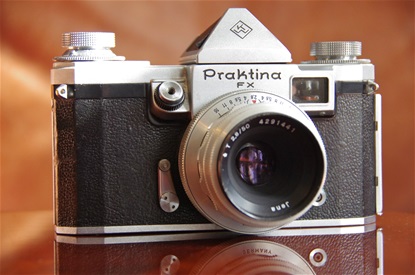
Praktina FX from 1953 was the worlds first system camera, a title often given to Nikon F that came 6 years later. Interchangable finder for PP or waist level and motor possibility were some features. The extra finder beside the prism made it possible to follow the subject even if the main finder was black, as there was no Instant Returning Mirror. Many years should pass before any German camera, east or west, should build in an IRM.
Size: 147x95x57 mm. Weight: 665 g.
Serial number: 25543.
Special lenses with special mounts. Here Carl Zeiss Jena Tessar 50/2,8. Sn. 4291441.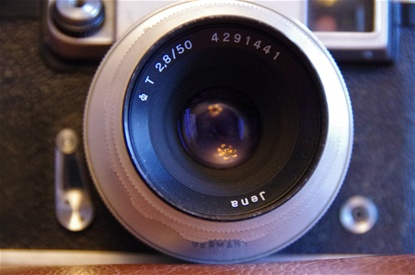
Special lenses with special mounts. Here Carl Zeiss Jena Tessar 50/2,8. Sn. 4291441.
Interchangable finder, winder and shutter speed to the right. DIN-scale and rewinder to the left. Shutter release button on the front in 45 degrees.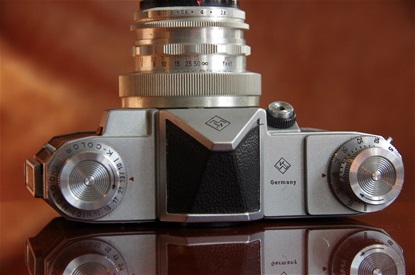
Interchangable finder, winder and shutter speed to the right. DIN-scale and rewinder to the left. Shutter release button on the front in 45 degrees.
Some parts of the system..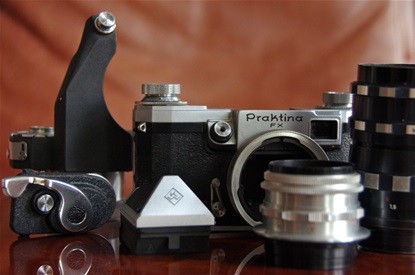
Some parts of the system..
Worlds first motor drive! Supposed to give 10 frames pr full winding, but mine gives 17!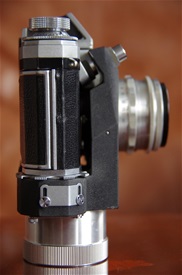
Worlds first motor drive! Supposed to give 10 frames pr full winding, but mine gives 17!
The key to the external winders..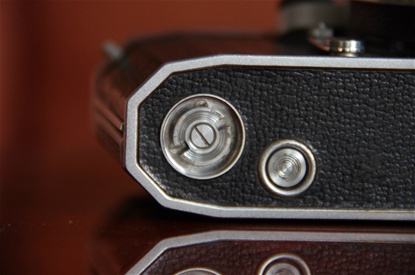
The key to the external winders..
Praktina el motor for 12 V battery, also for remote control. Sn. 71555.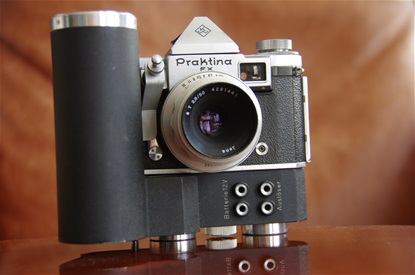
Praktina el motor for 12 V battery, also for remote control. Sn. 71555.
1954: West Germany: Wirgin Edixa Reflex
Wirgin of Wiesbaden in West-Germany made their first SLR camera in 1953. This was a waist level camera, and the name was Komet. However, as others claimed the right to that name, Wirgin renamed it in '54, and launched the pentaprism edition under the name Edixa. This is a model A with serial number 76734. It is rather rare today compared to the later B-models from 1957. The main external differences were the two flash sockets with no connecting bridge, the lack of on/off switch on the top of the front wall, and the shape of the shutter time control, with shutter times from 1/25 to 1/500.
Later models would have 1/1000 and long shutter times added.
Wirgin of Wiesbaden in West-Germany made their first SLR camera in 1953. This was a waist level camera, and the name was Komet. However, as others claimed the right to that name, Wirgin renamed it in '54, and launched the pentaprism edition under the name Edixa. This is a model A with serial number 76734. It is rather rare today compared to the later B-models from 1957. The main external differences were the two flash sockets with no connecting bridge, the lack of on/off switch on the top of the front wall, and the shape of the shutter time control, with shutter times from 1/25 to 1/500.
Later models would have 1/1000 and long shutter times added.
The Steinheil Cassar S 50/2,8 followed many of the first Edixas. Wirgin chose to follow the East-German M42 mount, and not the leaf shutter lenses that most other West-German producers would use. Two smart decisions.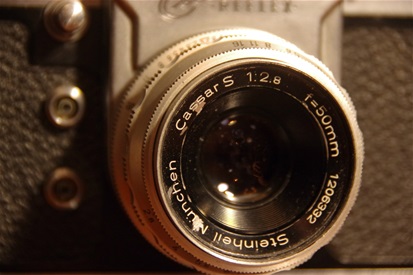
The Steinheil Cassar S 50/2,8 followed many of the first Edixas. Wirgin chose to follow the East-German M42 mount, and not the leaf shutter lenses that most other West-German producers would use. Two smart decisions.
Shutter times from 1/25 to 1/500. World's first right hand winder on a 35mm PP SLR.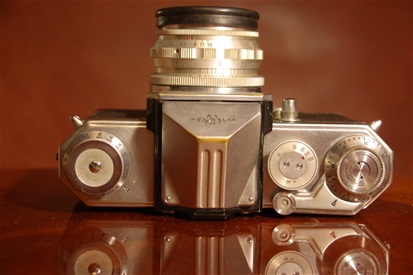
Shutter times from 1/25 to 1/500. World's first right hand winder on a 35mm PP SLR.
Technically, Wirgin made the most advanced PP SLR of the West-German brands. 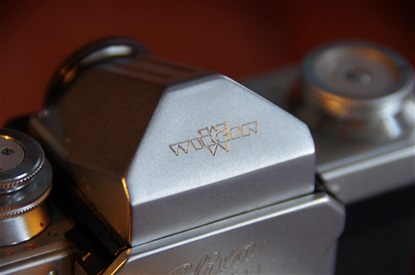
Technically, Wirgin made the most advanced PP SLR of the West-German brands.
|
|
 |
|
|
|